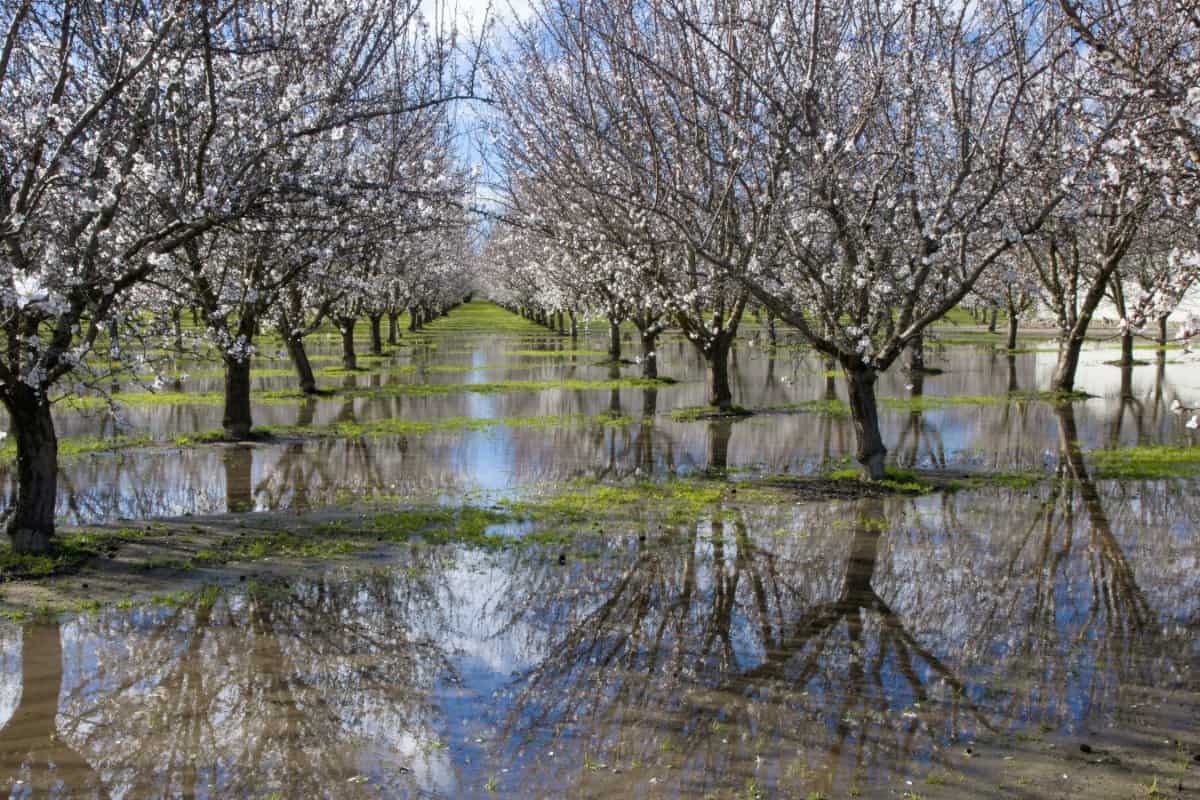

Photo: Standing water in a blooming almond orchard cause by excessive rain near Manteca, California.
After years of drought and dozens of recent atmospheric rivers, Central California farmers have revamped an old practice: intentionally flooding fields for deep irrigation and restoration of underground aquifers.
After the first of California’s winter storms, Michael Naito went out into his dormant fields to open his water valves, intentionally flooding the land. The fields filled up like a bathtub over the next three days. The water rose until it covered the feet of his leafless pistachio and almond trees, as well as the tangles of barren grape vines. It looked like an ephemeral pond that disappeared over the next few weeks.
“It’s kind of a deep irrigation,” said Naito, who has continued this practice over the past few months, flooding 250 acres of his 600-acre farm in California’s Central Valley.
As the water sinks in, it travels deeper underground to slowly percolate into the underlying aquifer. The practice, called managed agricultural groundwater recharge, probably looks strange to the uninitiated, but it’s seen as an increasingly important task during years with a water surplus in the state.
After a series of very dry years in California, this year 31 atmospheric rivers have brought reams of moisture from the tropics, drenching once-dry basins, capping the Sierra Nevada mountains with snow, and flooding several regions. The state’s water cycle is broken, and it has created a crisis of misplaced water. In addition to an ongoing war over surface water, in which the agriculture industry and conservation community have often been at odds, there’s widespread consensus that the disappearing groundwater has reached crisis level. Wells have run dry, deeper wells have been dug, and the land in many counties is literally sinking after water was rapidly drained from underground aquifers.
That’s why Naito and several other farmers have been intentionally flooding farmland to stow water underground, helping restore underground aquifers.
“You’re putting the water on when the plants don’t need it very much,” said Naito. The water stays on the field longer, and it is less prone to evaporation in the winter. He’ll generally flood the sandiest parts of his land, where the water can move quickly downward.
This practice requires the same tools as flood irrigation, an approach that was once practiced by most farmers in California. It’s still the most common form of irrigation globally. “You put the water out and what the plant didn’t use, the majority of it went back into our aquifer,” said Naito. But over the past […]
Full article: These Farmers Recharged Groundwater by Catching Atmospheric Rivers
Clean water is essential for life, yet millions of Americans unknowingly consume contaminants through their…
Human brains contain higher concentrations of microplastics than other organs, according to a new study, and the…
From the Office of the Governor: In anticipation of a multi-day, significant atmospheric river in Northern California,…
From Governor Newsom: Scientists, water managers, state leaders, and experts throughout the state are calling…
Photo: A harmful algal bloom in Milford Lake, Kansas, made the water appear bright green.…
An expanded plastic foam coffee cup is at a donut shop in Monterey Park, California.…